|
|

A Quick Look at Polyester Monofilament Strings
By Steve Crandall
Vice President, Sales & Marketing
Ashaway Racket Strings
I've been invited to host a Round Table discussion on monofilament strings at this year's Grand Slam Stringer's Symposium in September. In preparation for this, I've had our Ashaway lab run some tests on a good cross-section of monofilament strings currently on the market, including the top sellers. I think the results are worth discussing here.
Now before I go on, I need to make a disclaimer: Ashaway's lab is not a Certified, independent lab. That means the numbers presented here are "unofficial." Nevertheless, our lab is pretty good, and whenever we compare data with Certified independent labs, we agree very well.
The results of our tests on tensile strength and elongation are shown in the chart below. For those who may not be familiar with these tests, tensile strength is the force required to stretch a string to its "necking" point, which is when it begins to deform just before it breaks. "Elongation" is the amount a string stretches at racquet tension - in this case, 55 lbs. - expressed as a percentage of length.
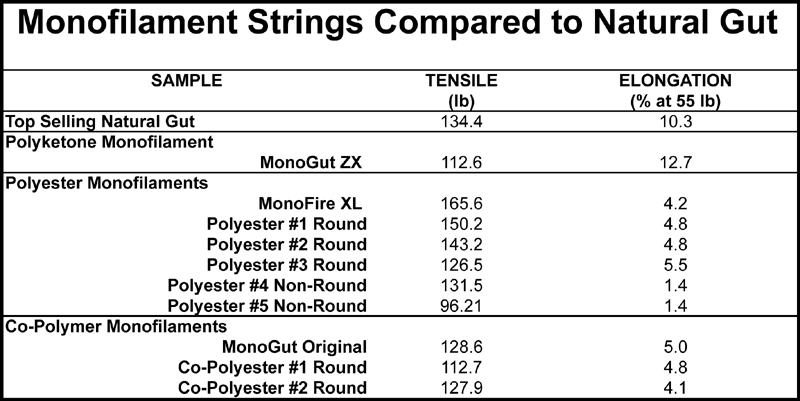
A couple things are immediately apparent from looking at this chart. The first is that the lion's share of monofilament strings are made from polyester, or copolymer with properties very close to polyester. The second thing is that all of these leading brands, including our own MonoFire® XL polyester and MonoGut® copolymer, are very similar. For the most part, these strings are stronger than the gold standard, natural gut, and they elongate from two to seven times less.
Another similarity, not shown on the chart, is the profile shapes of polyester monofilaments: they are either round and smooth; round with a rough, textured surface; or out of round with a twisted, polygonal shape and a smooth surface. But it's the tensile and elongation numbers that are our main concern.
Tensile strength translates into durability. Polyester and co-polyester strings are very tough and durable, as evidenced by the number of heavy-hitters who swear by them. Elongation translates to stiffness, and polyesters are some of the stiffest materials on the planet. As an aside, braided polyester lines are used extensively in boating and sailing because of their strength and stiffness, and one kindred material, marketed as Vectran®, is actually stronger and stiffer than some stainless steel wire.
But what does stiffness mean in a tennis string? It means it has less elasticity: it doesn't stretch as much. As you can see from the chart, while both Polyester #1 and #2 are stronger than natural gut, their elongation is only 4.8%. That means gut stretches more than twice as much when impacted by a ball. And gut stretches nearly 7.5 times more than Polyesters #4 and #5, rated at 1.4%. Our new Zyex®-based MonoGut ZX (made from a polyketone, or PEEK, polymer) outstretches these same strings by a factor of 9.
As we discussed in a recent column on Zyex-based strings, elasticity equates to "dynamic stiffness," or the ability of a string to snap back, like a rubber band. The better the elasticity, the more power the string returns to the ball. The less elasticity, the more energy is lost in flattening the ball and the less total power is available for rebound. And the better the elasticity or dynamic stiffness, the less impact shock a ball strike has on your arm and elbow: the string plays "softer." As a class, polyester and copolymer strings have poor dynamic stiffness and play very hard.
Just what this means even for top pros was pointed out in a recent Wall Street Journal article by Kristina Dell, "Tennis, Without all the Tension," (WSJ March 7, 2012). The article reported a growing trend among touring professionals - both men and women - to lower their stringing tensions with polyesters. More and more players, including Roger Federer, are asking their stringers "to shave as many as 20 pounds off their string tensions."
The rule of thumb for stringing tension has always been to string at low tension for more power and at high tension for more control. Said the Journal, "Racket strings have more punch when they're strung loosely because the ball dwells on the string bed longer, creating a trampoline effect. Years ago, when players used natural gut strings, this kind of slingshot power came at the expense of control - so most players opted for tighter strings and pinpoint placement."
But if a string has less stretch in it to begin with, it doesn't need high tension to maintain control, it needs lower tension to generate power. And if touring pros need to reduce tension to generate more power with polyester strings, what does that say about the rest of us?
There is another price to be paid for playing with polyesters at high tension as well: stress and potential injury. According to the Wall Street Journal, quoting Roman Prokes, stringer for Andy Roddick and Caroline Wozniacki, reducing tension by 10% with polyester strings, "puts less stress on the arm… People are used to seeing 60 pounds and then you suggest stringing at 45 pounds and they think it's crazy. But it's easier on everybody's shoulders and just works better."
I believe these characteristics of polyester monofilaments - gut on steroids, as they are called - are also responsible for two other trends I've noticed. One is that recreational players are losing their infatuation with high-end polyester. They don't like the impact, and they're realizing that normal everyday players just don't get enough benefit from these strings to warrant the added cost. Instead, they're turning back to more traditional multi-filament and synthetic gut strings, which offer a good combination of performance, economy and durability.
The second trend is the huge explosion in hybrid stringing. And it's easy to understand. Who would want a 100% polyester string bed that is so stiff and unforgiving? Players of all stripes - including most of the players I saw at this year's US Open - are using polyesters for stiffness and durability, but mixing it with a softer string for playability. Now, everyone's game is unique and string preferences range widely. But from my perspective as a string manufacturer, I don't think today's polyesters are the end of the story.
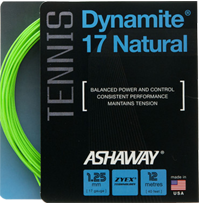 |
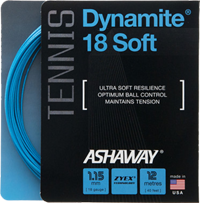 |
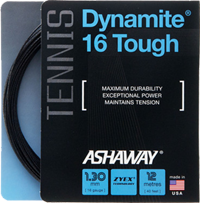 |
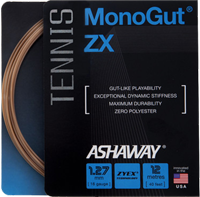 |
| Unlike polyesters and co-polymers, which are primarily monofilament constructions, Zyex can be constructed as a multifilament (Ashaway Dynamite 17 Natural or Dynamite 18 Soft); as a multistranded monofilament (Ashaway Dynamite 16 Tough); or, as a straight monofilament in our new MonoGut ZX and MonoGut ZX Red. This, along with a broader range of gauges than either polyesters or gut, allows players to more closely tailor their string choice to their style of play. |
|